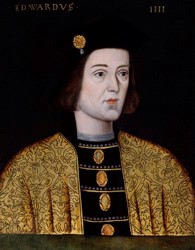On March 4, 1461, Edward, Duke of York, was crowned king of England, ending 62 years of Lancastrian rule. The Yorkists would rule England for most of the next 24 years.
Edward Victorious Over Henry VI
Between 1455 and 1487, the House of York and the House of Lancaster fought over control of the English crown in a civil war known as the Wars of the Roses. The Lancastrians had seized the English throne in 1399 and held it for three generations of rulers: Henry IV, Henry V and Henry VI.
Henry VI, who was an infant when he became king of England and France in 1422, was a pious, but ineffectual leader. Under his rule, taxes were exceedingly high, the countryside was lawless and the English army suffered numerous defeats against France in the Hundred Years’ War. Henry suffered a bout of insanity in 1453 and was forced to cede control of the government.
Richard, Duke of York, who had a claim to the throne that was arguably stronger than Henry’s, became protector and ruled the country in Henry’s stead; when Henry recovered from his illness, his wife, Queen Margaret of Anjou, and his Lancastrian cousin Edmund Beaufort, Duke of Somerset, attempted to wrestle the protectorship back from Richard, who prepared for battle.
In May 1455, Richard led an army of about 3,000 men to victory against Henry’s forces in St. Albans, a town north of London, marking the start of the Wars of the Roses. Somerset was killed in the battle and the queen fled London with her son. Richard and Henry reached an uneasy peace that lasted for four years before war broke out again.
In July 1460, a Yorkist army under the command of Richard Neville, Earl of Warwick, defeated the King’s forces at Northampton. Henry was captured by the Yorkists and forced to name Richard, Duke of York, his successor; however, Richard was killed at Wakefield in December 1460, again leaving the succession in dispute.
Related Content
Richard’s son Edward continued the fight, defeating a Lancastrian army at Mortimer’s Cross in February 1461. Meanwhile, the queen’s army defeated Yorkist forces at the Battle of St. Albans and rescued Henry. However, her actions after the battle may have cost her husband the throne.
Encyclopedia Britannica explains: “Margaret then allowed her victorious army to pillage the town and the Abbey of St. Albans; hearing of this, the City of London sent to say that she would not be admitted unless she could guarantee her troops’ good behaviour. While she hesitated, Edward and Warwick entered London, where Edward was hailed as King Edward IV.”
The queen’s army retreated north, pursued by Edward’s forces. On March 29, a day after winning the Battle of Ferrybridge, the Yorkists defeated the queen’s army at Towton in the bloodiest battle in the Wars of the Roses. The loss forced Henry, Margaret and their son to flee to Scotland, leaving King Edward IV in control of England.
Sources in this Story
- Encyclopedia Britannica: Wars of the Roses
- College of Staten Island, City University of New York: Online Reference Book for Medieval Studies: Beginning of the Wars of the Roses
- Luminarium: Encyclopedia Project: The Wars of the Roses
- HistoryNet (Military History Magazine): Wars of the Roses: Battle of Towton
Historical Context: The Wars of the Roses
The Wars of the Roses refer to a dynastic conflict fought between the House of York and the House of Lancaster, each of which made claims to the English throne through the sons of King Edward III, who had died in 1377. Each house was depicted by a rose: a red one for the Lancastrians and a white one for the Yorkists.
The defeat of Henry VI by Edward IV ended 62 years of Lancastrian rule. However, infighting within the House of York led to Edward being deposed and Henry being restored to the throne in September 1470. Edward regrouped and defeated Henry’s forces in April 1471. Henry and his son were killed, securing Edward’s control of the crown.
Edward died in 1483, leaving the throne to his 12-year-old son, Edward V. However, Edward IV’s brother, Richard, Duke of Gloucester, imprisoned both the young king and his younger brother in the Tower of London, where they would both be mysteriously killed. Richard assumed the throne as Richard III, but his reign would be short and unpopular.
Yorkist defectors rallied behind Henry Tudor, a Lancastrian living in France. Henry raised a powerful army and killed Richard in the Battle of Bosworth in August 1485. He put himself on the throne and married Elizabeth of York, the daughter of Edward IV, thereby uniting the Houses of Lancaster and York. He formed the House of Tudor, which was marked by a red and white rose symbolizing the unity of the two houses and the end of the Wars of the Roses.
WarsoftheRoses.com gives simple overviews of the battles and key figures of the Wars of the Roses. It also includes an excerpt from Philip A. Haigh’s 1996 book “Battle of Wakefield 1460.”
The Luminarium explains the wars in much greater depth, with a thorough examination of the causes of the wars and detailed biographies and battle summaries. that explains the origins of the wars.











